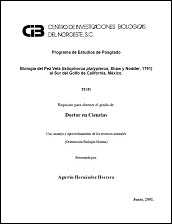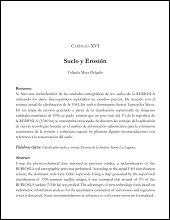Caracterización fisiológica de tres fenotipos de Mesembryanthemum crystallinum y análisis de la expresión de los genes antiporte McNhx1 y McNhx2 durante el estrés salino
Resumen
"Los transportadores tipo antiporte Na+/H+ (NHXs) son proteínas integrales que residen en la membrana plasmática, compartimentos endosomales y en vacuolas, encargados del intercambio electroneutral de Na+ y/o K+ por H+ con la finalidad de dirigir el movimiento de iones hacia afuera de la célula, al interior de la vacuola u organelos intracelulares. Con ello contribuyen en la regulación del pH vacuolar, la homeostasis celular del K+, la expansión celular, el tráfico vesicular, el direccionamiento de proteínas y la tolerancia a la salinidad. Mesembryanthemum crystallinum (vidrillo o ice plant) se ha propuesto como un modelo de estudio para el estrés abiótico. En estudios realizados en CIBNOR sobre el perfil de expresión del gen McNhx2 de vidrillo, se observó que induce su expresión en respuesta a estrés salino (Warner-Urías, 2010) lo que difiere de los resultados descritos por Cosentino et al. (2010) en dónde no detectan la expresión de dicho gen en respuesta a estrés. Por lo que el presente trabajo se planteó estudiando 3 fenotipos de vidrillo y su respuesta fisiológica y molecular al estrés salino. Se emplearon plántulas de 6 semanas de edad de tres fenotipos de vidrillo identificados por el Dr. Andres Orduño (unidad Guerrero Negro, CIB) como P0, P9 y P11 en tratamiento con NaCl 500 mM. Como parámetros fisiológicos se evaluaron: el potencial hídrico, el contenido de humedad, relación PS/PF, contenido de prolina, contenido de Na+ y K+ y contenido de clorofila. Y en el aspecto molecular, se evaluó la expresión de los genes McNhx1 y McNhx2. En los 3 fenotipos (principalmente P11) se observó una disminución en el potencial hídrico y contenido de humedad como respuesta al estrés salino. No se observaron diferencias significativas en el contenido de prolina en respuesta a estrés salino, pero se encontró una tendencia a aumentar debido al estrés principalmente el fenotipo P11. El contenido de Na+ en presencia de salinidad incrementó significativamente en los fenotipos P9 y P11 principalmente. El contenido de K+ en presencia de salinidad disminuyó significativamente siendo menor en P9 y P11 que en P0. El análisis para la relación Na+/K+ en condiciones control, mostró un incremento de 7 veces en P11 con respecto a P0 y P9..." "The Na+/H+ (NHXs) antiporters are integral proteins that reside in the cell membrane endosomal compartments, and in vacuoles. NHX antiporters catalyze the electroneutral exchange of Na+ and/or K+ for H+ to direct ion movement out of the cell, into the vacuole or intracellular organelles, which contributes to vacuolar pH regulation, K+ cell homeostasis, cell expansion, vesicular trafficking, protein targeting, and salt tolerance. Mesembryanthemum crystallinum (vidrillo or ice plant) has been proposed as a model to study abiotic stress. In CIBNOR studies on the McNhx2 gene expression profile of vidrillo, it was observed to induce expression in response to salinity stress (Warner, 2010), which differs from that described by Cosentino et al. (2010) where they do not detect the expression of this gene in response to stress. In this work we studied 3 vidrillo phenotypes and their molecular and physiological response to salt stress. We used 6-week seedlings of 3 vidrillo phenotypes identified by Dr. Andrés Orduño (Guerrero Negro Unit, CIB) as P0, P9, and P11 treated with 500 mM NaCl. As physiological parameters we evaluated: water potential, moisture content, DW/FW ratio, proline content, Na+ and K+ content, and chlorophyll content. McNhx2 and McNhx1 gene expression were evaluated at molecular level. The 3 phenotypes (mostly P11) showed a decrease in water potential and moisture content in response to salt stress. There were no significant differences in proline content in response to salt stress, but there was a tendency in the P11 phenotype to increase due to stress. Na+ content increased significantly with salinity mainly in P9 and P11 phenotypes. K+ content decreased significantly with salinity, which was lower in P9 and P11 than in P0. P11 phenotype under control conditions still showed a Na+/K+ ratio 7 times larger than in P0 and P9. In the presence of salt stress, the Na+/K+ ratio significantly increased twice in P9 and P11 with respect to P0. While assessing chlorophyll content, we found a significant increase in chlorophyll a in the 3 phenotypes in the presence of salinity, but there were no significant changes in chlorophyll b content. P11 did not show increase in total chlorophyll as P0 and P9..."
Colecciones
Ítems relacionados
Mostrando ítems relacionados por Título, autor o materia.
-
PROMOCIÓN DEL PERIFITON PARA EL CULTIVO DE CAMARÓN BLANCO: HACIA UNA ACUICULTURA ECOLÓGICA
DOMENICO VOLTOLINA LOBINA; JUAN MANUEL AUDELO NARANJO; MARIA DEL ROSARIO PACHECO MARGES -
Suelo y Erosión
YOLANDA LOURDES MAYA DELGADO


